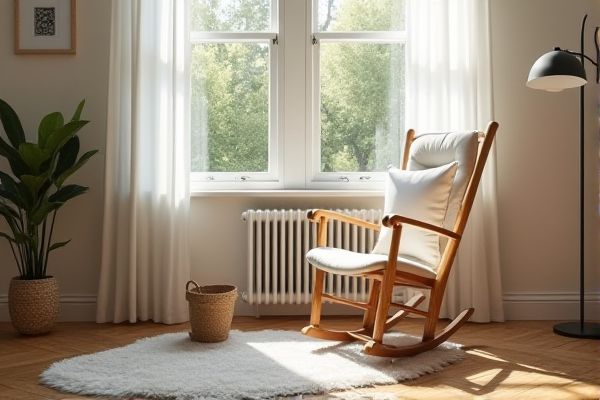
A glider chair provides smooth, horizontal motion ideal for soothing relaxation, while a rocking chair offers a traditional back-and-forth rocking experience that can be both calming and invigorating. Discover which chair suits your comfort needs best by reading the rest of the article.
Table of Comparison
| Feature | Glider Chair | Rocking Chair |
|---|---|---|
| Movement | Smooth horizontal gliding motion | Arcing back-and-forth rocking motion |
| Mechanism | Sliding tracks or rails | Curved rockers attached to legs |
| Comfort | Stable, gentle, less jarring | Traditional, rhythmic sway |
| Common Uses | Nurseries, relaxing seating | Indoor/outdoor seating, porch use |
| Design Styles | Contemporary and nursery-focused | Classic, vintage, rustic styles |
| Space Requirement | Requires less floor space | Needs more floor space for rocking arc |
| Price Range | Moderate to high | Low to moderate |
| Maintenance | Requires track lubrication | Minimal, occasional tightening |
Introduction to Glider Chairs and Rocking Chairs
Glider chairs feature a smooth, gliding motion on a fixed track, providing a gentle and quiet seating experience ideal for nurseries and relaxation. Rocking chairs operate with curved legs that create a traditional rocking motion, often associated with classic design and outdoor use. Both chairs offer soothing movement but differ in mechanism and style, catering to various preferences and environments.
Design Differences: Glider vs Rocking Chair
Glider chairs feature a mechanism that allows smooth, horizontal gliding motion, whereas rocking chairs provide a curved base enabling a traditional rocking motion. The glider's frame typically includes metal or wooden linkage arms that move back and forth in a fixed path, while rocking chairs rely on curved rockers attached directly to the legs. This design difference results in gliders offering a more stable and controlled movement, ideal for nurseries, whereas rocking chairs provide a classic rocking experience often favored for relaxation.
Comfort and Ergonomics Comparison
Glider chairs offer smoother, quieter motion ideal for soothing infants, featuring cushioned seats and lumbar support for enhanced comfort and reduced strain during extended use. Rocking chairs provide a traditional rocking motion with a firmer seat and less ergonomic support, which may lead to discomfort during prolonged sitting. Ergonomically, gliders are superior for maintaining proper posture and minimizing joint stress, making them better suited for long-term relaxation.
Space and Placement Considerations
Glider chairs require less clearance space compared to rocking chairs because their smooth sliding motion moves linearly without extending forward or backward. Rocking chairs need ample space around to accommodate their curved rocking arc, which may limit placement options in smaller rooms. Choosing between the two depends on room size and layout, with gliders fitting better in compact areas and rockers suiting more open spaces.
Noise Levels: Which Chair is Quieter?
Glider chairs operate on a smooth, gliding mechanism that produces minimal noise, making them quieter than traditional rocking chairs, which often create creaking sounds due to their curved runners. The stationary base of glider chairs reduces friction and contact with the floor, further lowering noise levels. In environments requiring low noise, such as nurseries or offices, glider chairs are generally preferred for their silent operation.
Safety Features and Concerns
Glider chairs typically feature smooth, controlled back-and-forth movement on a fixed track, reducing the risk of tipping over compared to rocking chairs, which have curved legs allowing wider arcs that may cause instability. Safety considerations for glider chairs include secure locking mechanisms and sturdy base construction to prevent accidental sliding or tipping, while rocking chairs require attention to floor surface traction and gradual rock design to avoid abrupt movements. Both styles benefit from padded armrests and stable frames, but gliders are often preferred in nurseries due to their gentle motion and enhanced stability for infants and elderly users.
Maintenance and Durability
Glider chairs feature a smooth gliding mechanism with fewer moving parts, reducing wear and the need for frequent maintenance compared to rocking chairs, which rely on curved rockers prone to loosening over time. Upholstery durability in both chair types depends on fabric quality, but glider chairs often incorporate cushioned seats and sturdy frames designed for consistent motion, enhancing longevity. Regular lubrication and tightening are essential for rocking chair joints to prevent creaking and structural degradation, whereas glider chairs typically require less intensive upkeep due to their stable track system.
Price Range and Budget Factors
Glider chairs typically range from $150 to $500, offering a smoother, more modern motion ideal for nurseries, while rocking chairs often cost between $100 and $400, favored for their classic design and simplicity. Your budget should consider factors such as upholstery quality, frame durability, and added features like padded armrests, which can significantly impact the overall price. Choosing between a glider and a rocking chair depends on your preference for comfort and style relative to how much you're willing to invest.
Best Uses and Ideal Rooms
Glider chairs provide smooth, horizontal motion making them ideal for nurseries and bedrooms where comfort and relaxation are priorities during feeding or reading sessions. Rocking chairs, with their arched runners allowing a back-and-forth rocking motion, suit living rooms, porches, and outdoor patios perfect for socializing or casual relaxation. Both chair types optimize comfort but their distinct movements complement different room functions and activities.
Which Chair Should You Choose?
Choosing between a glider chair and a rocking chair depends on your comfort preferences and space requirements. Glider chairs offer smooth, horizontal sliding motions ideal for nurseries or long sitting sessions, while rocking chairs provide a traditional curved motion that can be more compact and classic. Your decision should consider the chair's motion style, cushioning, and how it fits into your room's aesthetics and functionality.
 homyna.com
homyna.com